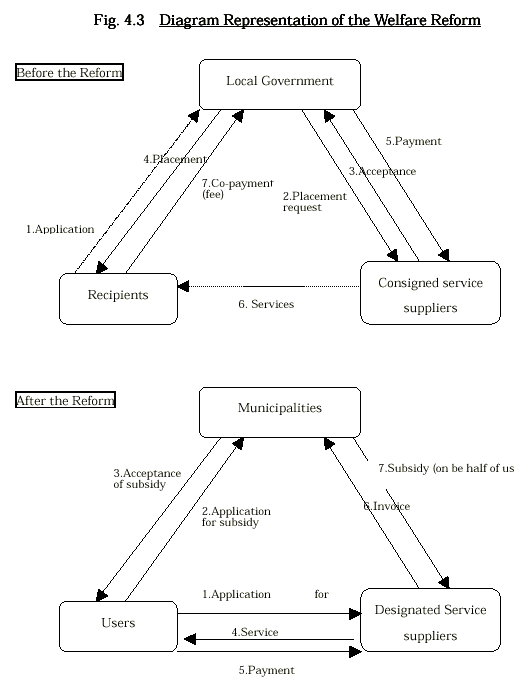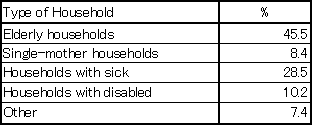
The social assistance in Japan can be divided into: (1) Income assistance for the poor and (2) Social services and assistance for socially disadvantaged people. The former is called the Public Assistance, while the latter includes Welfare for the Children, Welfare for the Disabled, Welfare for Single-Mother Households, and Welfare for the Mentally Disabled People depending on the specified target group. The Public Assistance includes both in-kind and in-cash assistance to the poor household, while the latter includes mostly services such as at-home and institutional services, but sometimes in-cash assistance. Thus, the term welfare is used widely to indicate various social assistance programs and institutions that fall within the above-mentioned areas. Most of these programs, institutions and services are provided from the general budget of the government and municipalities.
Until the Long-Term Care Insurance was introduced in 2000, the services for the elderly were also termed the "Welfare for the Elderly". However, many services for the elderly are now covered by the Long-Term Care Insurance, and thus, it will be discussed in Chapter 5.
2. Means test and universalityThe Public Assistance Law stipulates a principle that every citizen has a right to claim public assistance without discrimination, regardless of reasons for falling into hardship. However, the Public Assistance is provided with fairly strict means and asset tests, which might be a reason for low percentage of population receiving the public assistance. The Child Allowance and Child Rearing Allowance for single-mothers are also provided with a means test, but the threshold is much higher than that for the Public Assistance.
On the other hand, most of the services provided at institutions for the disabled and children are provided to all, even though there is a difference in fee depending on the income of the recipient.
Here, main features of the following three categories of the social assistance will be described. Income assistance, rather than services, will be the main focus of the discussion.
The root of Japan's public assistance goes back to poor relief before the World War II. Today's public assistance has its legal basis on the Revised Public Assistance Law (New) enacted in 1950. The Law stipulates four fundamental principles: (1) public assistance to the people in need is a responsibility of the state, (2) all citizens have a right to claim public assistance without discrimination of sex, social background and reasons for falling into hardship, and only the economic condition is the criteria of receiving assistance, (3) the state guarantees to all citizens a minimum level of healthy and cultural life, and (4) public assistance is a supplement to all resources available to and the best efforts exerted by the applicant.
The public assistance is provided upon a receipt of an application from a household in need and after a careful examination of the application. The assistance is calculated by subtracting the household's final income from the minimum cost of living. In case the minimum cost of living exceeds the final income, the difference is given as the assistance. The minimum cost of living is calculated from seven categories of expenses: livelihood, housing, educational, medical, maternity, occupational, and funeral expense. The calculation of the minimum cost of living takes into consideration the differences in living costs among different regions of the country, and household members' age. All assistance is provided as cash transfers, except a few such as medical costs, which are provided as in-kind.
(a) Means testThe principle (4) of the Public Assistance states that the Public Assistance must be a supplement to the person's best efforts and available resources. In other words, the person is required to use all available resources, including assets, ability to work, as well as assistance from those who are required to support the person by law. Assets such as land, houses and farms must be sold, except in the case where the person is actually living or utilizing it and the value of the assets is higher when it is utilized than when it is sold. Household goods such as TV are allowed if the diffusion rate of the goods is more than 70% in the region.
As for the utilization of the ability, the person will not be able to receive assistance if he/she is judged as capable to work. If the person has a will and ability to work, but is unable to find work, it is unlikely that he/she would be given assistance.
The civil law states that certain relatives and family members are required to support a person in need. Thus, the public assistance is given only after it is judged that this support is not available. In practice, spouses and parents of a minor (less than 20 years old) have strong responsibility to support the person.
(b) StatisticsIn 2000, 752 thousand households or 1,073 thousand persons (0.84% of the population) received some types of public assistance. The share of the population receiving the assistance had been declining until 1995, but since then there has been a slight, but continuous rise. Among them, the share of elderly household is the largest, accounting for 45.5% of all recipient households, and has been increasing for some years. The share of the household with a disabled or sick is also large, at 38.7%. Only 8.4% are single-mother households. The large share of households with the elderly, disabled or sick may be the reason that the most of recipient households (88.0% in 2000) do not have any working member.
Table 4.1 Percentage of Household Receiving Aid by Types of Household

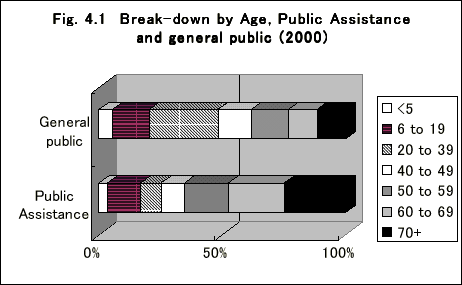
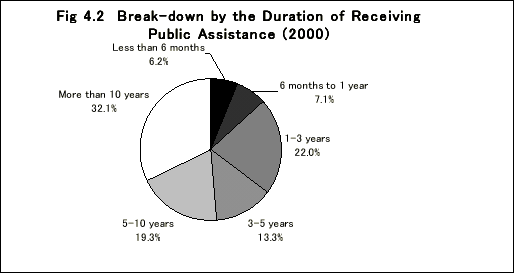
This is an area where there have been significant reforms within past few years. The new interest in reforming the Welfare for Children is spurred mainly due to the concern about the low fertility, now estimated to be at 1.33. First, in the past, the Child Allowance is granted to parents (or guardians) who are raising children less than 3 years old and whose income is less than a specified amount. Since June 2000, the age limit was raised to 6 years old and the income threshold was also raised. (See Table 4.2 for income threshold). The amount of the Child Allowance is \5,000 per month for the first two, and \10,000/month/child for other children. The financial burden of the Child Allowance for children 0 to 3 years old is born by employer, central, prefectural and municipal governments at 70%, 20%, 5%, 5% respectively for a recipient who is employed, and by the central, prefectural and municipal governments at 66%, 16% and 16% for a recipient who is not an employee. For children 3 to 6 years old, the entire financial burden is born by the government (central 66%, prefectural 16%, municipal 16%).
In addition, for a parent who is either employee or a public servant, a higher income threshold was set for receiving the Special Child Allowance (SCA). The amount of the Special Child Allowance is same as the Child Allowance, but the entire financial burden is born by his/her employer.
Table 4.2 Income Threshold for Child Allowance (2002)
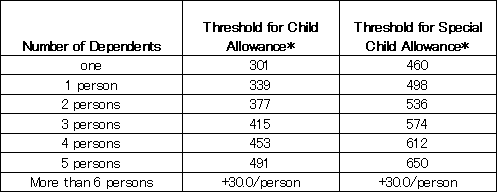
* Annual Income of previous year (unit:\10,000)
Table 4.3 Number of Child Allowance Recipients and Expenditure, 2000

Child Rearing Allowance is given to single-mothers who are rearing a child less than 18 years old, who does not share a common household income with father and whose earnings for the previous year is less than the threshold. The monthly allowance is \42,370 in case of one child, \47,370 in case of two children, and for third child and up additional \3,000 for each child. In 2002, the income threshold for receiving the full amount of the allowance was lowered and tapering of the allowance amount as the income rises was introduced. For a single-mother household of two (mother and a child), the income threshold is now stands at \3,650,000 for full allowance, and for those whose income is between \1,300,000 and \3,650,000, the allowance is tapered to zero.
(c) Child Care Facilities (Day-care centers, etc.)Municipal governments are required by the Child Welfare Law to provide day-care centers for children whose parents are not capable of taking care of them for reasons such as work, illness, and care of other members of the family. Day-care centers provide 8 hours of care, but demand to extend the hours has been increasing. The staffing and other quality measures are tightly regulated by the municipality. Fee for day-care centers depends on municipality, but usually depends on income and number of children.
3. Welfare for the DisabledThe measures for people with disabilities are divided into (1) those for people with physical disabilities, (2) for people with mental disorders, (3) for children with mental and physical disabilities and (4) adults with intellectual disability. Measures are mainly institutional services and in-home services. Tables 4.5 and 4.6 list services provided.
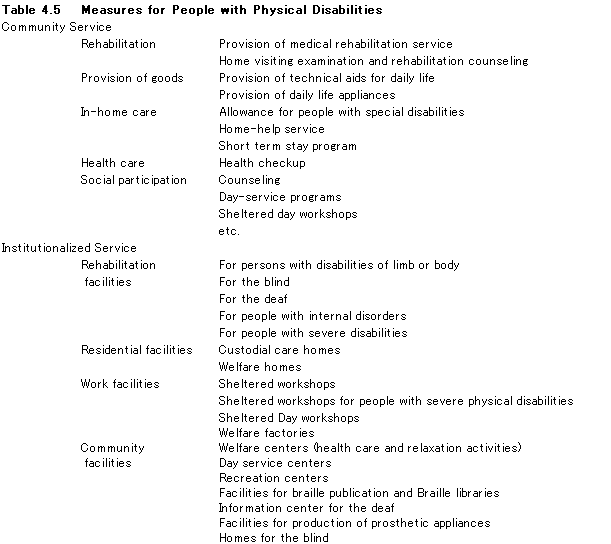
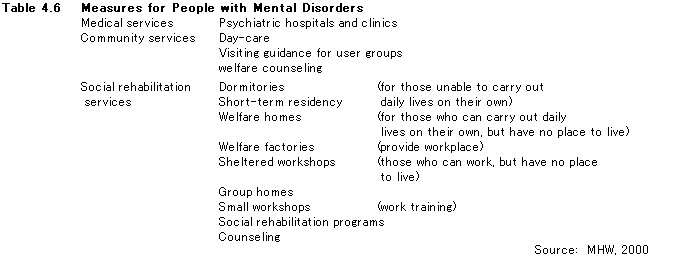
As for the income assistance, disability pensions under the National Pension, the Employees' Pension Insurance schemes, and the Allowance for Special Disabled Persons are granted for eligible persons with disabilities who are over 20 years of age. For households who are raising children with disabilities under age 20, the Family Allowance for Special Children and the Welfare Allowance for Disabled Children are applicable. If the sum of eligible allowances and any other income is under the minimum cost of living, the Public Assistance, as discussed in section II.1, is granted to secure the minimum standard of living. Amount of each allowance is summarized in Table 4.7.
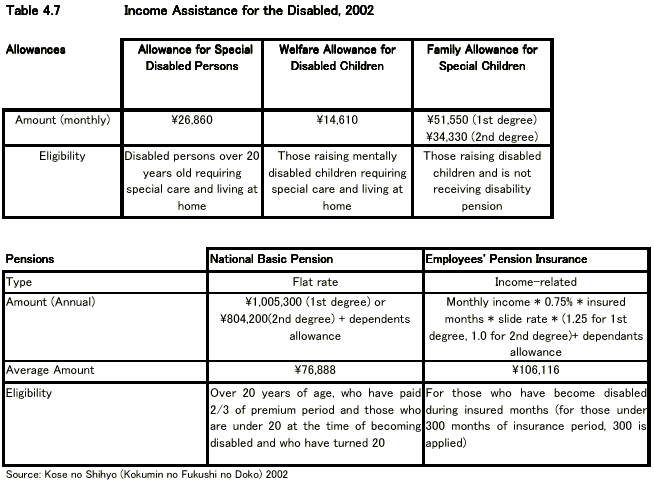
The 1945-55 conception of public relief for the poor still remains in the basic framework of social welfare in Japan. However, there is a growing awareness of the necessity to respond to the diverse welfare needs of people and to provide them with high quality services. With such an understanding, the government is carrying forward some reforms. First, in 1990, the Social Welfare system was revised to (1) place more emphasis on the at-home services, and (2) the services are standardized to be provided at municipality level. Since 1997, the government is carrying forward the Basic Structural Reform of Social Welfare.
The reform aims to establish a system that ensures the choice of individuals. Previously, specifically in case of services requiring institutionalization, the welfare offices assessed the need of the person in question and ordered appropriate measures. Under such a system, the user could not choose the service or the institution. Under a new system, an individual selects his/her own services and uses them based on a contract with suppliers. (Fig. 4.3) The reform has established the vision for the new social welfare, but concrete measures and programs are still being debated.
2. Need to create a society favorable to child rearingJapan has faced a rapid aging of the population, which is caused by both a decrease in the fertility rate and an increase in the life span. In order to stop the trend toward a society with a few children, it is necessary to create an environment favorable to child rearing. However, many Japanese working parents rely much on mothers staying at home or grandmothers taking care of children. As the number of working mothers rises, there has been a severe shortage of day-care centers, especially for 0 to 2 year olds, within metropolitan cities. In 1999, the Government has allocated a special supplemental budget to reduce the number of waiting children for day-care centers. Yet, more efforts in this field are needed to increase the number and diversify the kind of day-care centers and other measures to help working parents. Measures to help not only working parents but also non-working mothers, who are feeling stress of bringing up children in the absence of extended family and community ties, will work to create a child-rearing easy society.
